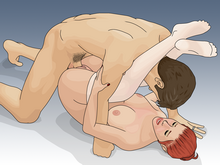Vaginal intercourse
Vaginal intercourse (from Latin vagina , German vagina and intercourse from sexual intercourse , coitus per vaginam ) is a sexual act in which an erect penis is inserted into the vagina . For this purpose, both sexual partners can relate to each other in different positions ( sexual practice ) of their bodies or genitals, such as the missionary position (vis a tergo) scientifically ventro-ventral copulation , or the coitus a tergo (vis a tergo), dorso-ventral copulation or the riding position .
Social evaluation

Vaginal intercourse is considered by many to be the "normal" form of intercourse between heterosexual partners. Depending on sexual morality , a completed marriage is seen as a cultural requirement; conversely, vaginal intercourse is referred to as (sexual) " consummation of marriage ". Hygienic or cultural reasons may require a woman to refrain from intercourse during menstruation .
execution
The prerequisites for natural, voluntary and above all painless vaginal intercourse are usually the moisture of the vagina (colloquial: being moist ), which is created either through its natural secretion during sexual arousal or through lubricating creams or the like. Can be brought about as well as an erect penis . A man's ejaculation during vaginal intercourse is generally one of the essential prerequisites for the natural generation of offspring.
From a biomechanical point of view, the musculoskeletal system in the various sexual positions is stressed to different degrees, especially the spine and the joints and muscles of the pelvic ring or pelvic floor . In the case of physical impairments ( disability ), suitable sexual positions must be selected, which, depending on the type of orthopedic or degenerative limitation, are still possible without symptoms.
The vaginal wall has more sensory receptors in certain zones . If both the extravaginal clitoris and the erogenous regions inside the vagina are stimulated long enough, many women reach orgasm (see G-spot , A-spot or others). The male “ corpus spongiosum penis ” is embryologically homologous to them. The existence of G and A points as clearly defined centers is not scientifically proven.
Insertion of the erect member into a vagina ( immissio penis )
Sagging penis ( Mutatio penis ) in front of a " vulva "
Direct influencing factors in vaginal intercourse

On the one hand, the positions that both partners take are fundamentally important, then the "pushing techniques", i.e. the frequency, the speed and the vaginal penetration depth. They also essentially determine the frictional performance (to a certain extent, rhythm and tempo ). There are a multitude of choreographic possibilities. Furthermore, the anatomical-morphological requirements of both partners, the "vagino-penile compatibility" or their adaptation to each other. Diverse combinations are possible from this. Although experiencing an orgasm is initially about adequate stimulation of the corresponding sensory receptors, there are still great individual differences in basic as well as in individual concrete situations. Some women need quick "pushes" in order to experience an orgasm, while other women prefer deep stimulation or lingering of the penis in the vagina.
In order to stimulate the intravaginal, erogenous zones through penile penetration during vaginal intercourse, on the one hand a corresponding level of sexual arousal prior to penetration ( foreplay ) is required in the woman and, on the other hand, thrusting techniques adapted to her needs, the penetration depth and the Angle of the penis matter.
The stimulation can be improved through suitable body positions, but also through a technique that corresponds to the needs of the rhythmic back and forth movements of the penis in adaptation to the movement of the female pelvis and her genitals. The angle between the erect and penetrating penis and the male abdomen has a major impact on achieving female orgasm. In the most common missionary position, the penis often does not sufficiently stimulate the upper vaginal wall along the urethra or the intravaginal erogenous zones. If you change the angle, e.g. B. when the woman puts her legs on the shoulders of her partner and the penis penetrates at a steeper angle or when penetrating from behind, the pressure on the wall along the urethra is greatest. For optimal A-point stimulation, in turn, it is recommended after every deep forward movement to reinforce this again with a small, strong, deep push intravaginally, this will penetrate the penis about another 1–2 cm deeper. A direct impact on the cervix can u. U. be perceived as unpleasant. The position of the uterus , whether anteflexed or retroflexed, can be significant and may then require a correction through appropriate sex positions or the perfect angle for penis and vagina.
Risk of infection
Vaginal sex can lead to infection with sexually transmitted diseases (STDs) if one of the two sex partners is infected.
literature
- Wilhelm Reich : Drive concepts from Forel to Jung, The coitus and the sexes . In: Journal of Sexology . 1921.
- K. Herold: Despite the desire to have children, seldom intercourse . In: Sexual Medicine 19. 1990, p 680-684.
- CA Fox, Beatrice Fox: A comparative study of coital physiology . In: J. Reprod. Ready , 1971, 24, pp. 319-336, reproduction-online.org (PDF).
Web links
- Sketch and representation of a cohabitation (in the sagittal sectional plane ) as well as the female erectile tissue around the urethra , corpus spongiosum of the Graefenberg zone in the anterior vaginal third and the A point in the area of the anterior cervical vault, fornix cervicalis anterior (English anterior fornix zone abbreviated AFE -zone ) i0.wp.com
Individual evidence
- ^ Alan F. Dixson: Sexual Selection and the Origins of Human Mating Systems. OUP Oxford, Oxford 2009, ISBN 978-0-19-156973-9 , p. 83.
- ↑ Natalie Sidorkewicz, Stuart M. McGill: Male Spine Motion During Coitus Implications for the Low Back Pain Patient. SPINE Volume 39, Number 20, pp. 1633–1639, PMC 4381984 (free full text)
- ^ Ernest Graefenberg: The Role of Urethra in Female Orgasm. The International Journal of Sexology, February 1950, vol. 3, p. 145 andreadrian.de (PDF)
- ↑ Per Olov Lundberg: The peripheral innervation of the female genital organs. Sexuologie 9 (3) 2002 98-106 sexuologie-info.de (PDF)
- ↑ Stuart Brody, Kateřina Klapilová, Lucie Krejčová: More Frequent Vaginal Orgasm Is Associated with Experiencing Greater Excitement from Deep Vaginal Stimulation Article. Journal of Sexual Medicine 10 (7), April 2013, pp. 1730–1736 researchgate.net (PDF)
- ↑ RM Costa, GF Miller, S. Brody: Women who prefer longer penises are more likely to have vaginal orgasms (but not clitoral orgasms): implications for an evolutionary theory of vaginal orgasm. In: J Sex Med. , 2012 Dec, 9 (12), pp. 3079-3088
- ↑ Willibrord Weijmar Schultz, Pek van Andel, Ida Sabelis, Eduard Mooyaart: Magnetic resonance imaging of male and female genitals during coitus and female sexual arousal. In: BMJ. Volume 319, number 7225, 1999 Dec 18-25, pp. 1596-1600, doi : 10.1136 / bmj.319.7225.1596 , PMID 10600954 , PMC 28302 (free full text).
- ^ H Alzate, ML. Londono: Vaginal erotic sensitivity. In: J Sex Marital Ther , 1984, 10, pp. 49-56
- ↑ Angle of the body of the uterus in relation to the cervix (flexio) y7177.com
- ↑ the female analogue of the corpus spongiosum penis
- ↑ Chua Chee Ann: A proposal for a radical new sex therapy technique for the management of vasocongestive and orgasmic dysfunction in women: The AFE Zone Stimulation Technique. In: Sexual and Marital Therapy. 12, 1997, p. 357, doi: 10.1080 / 02674659708408179 .




